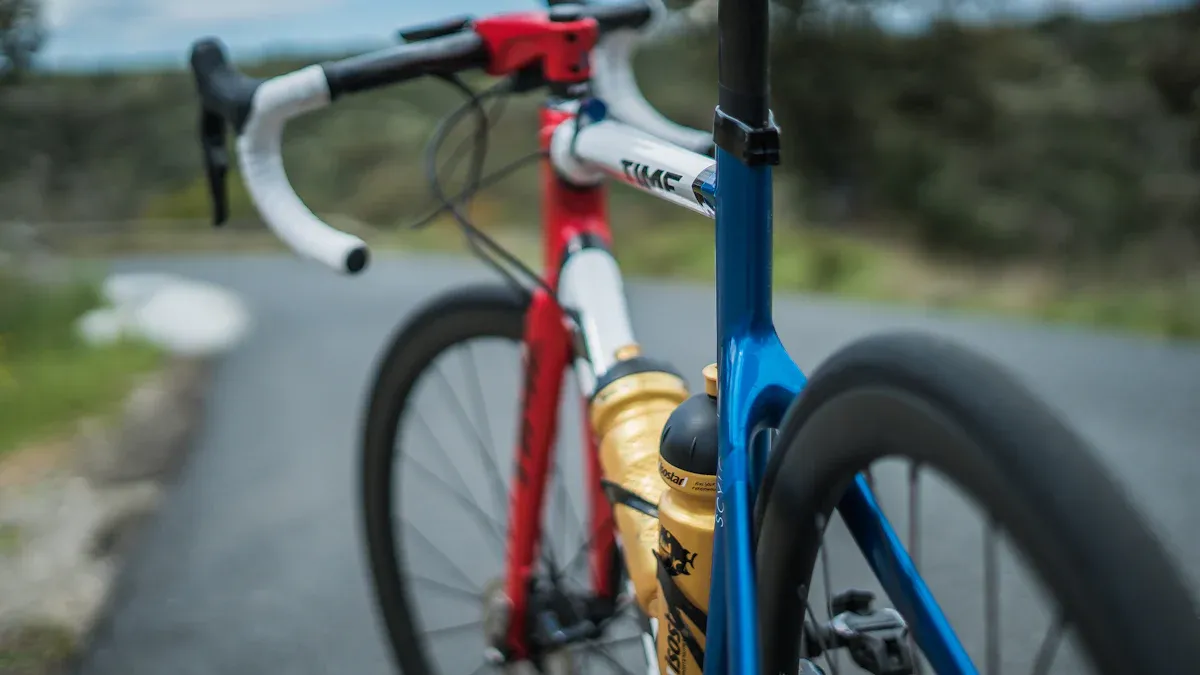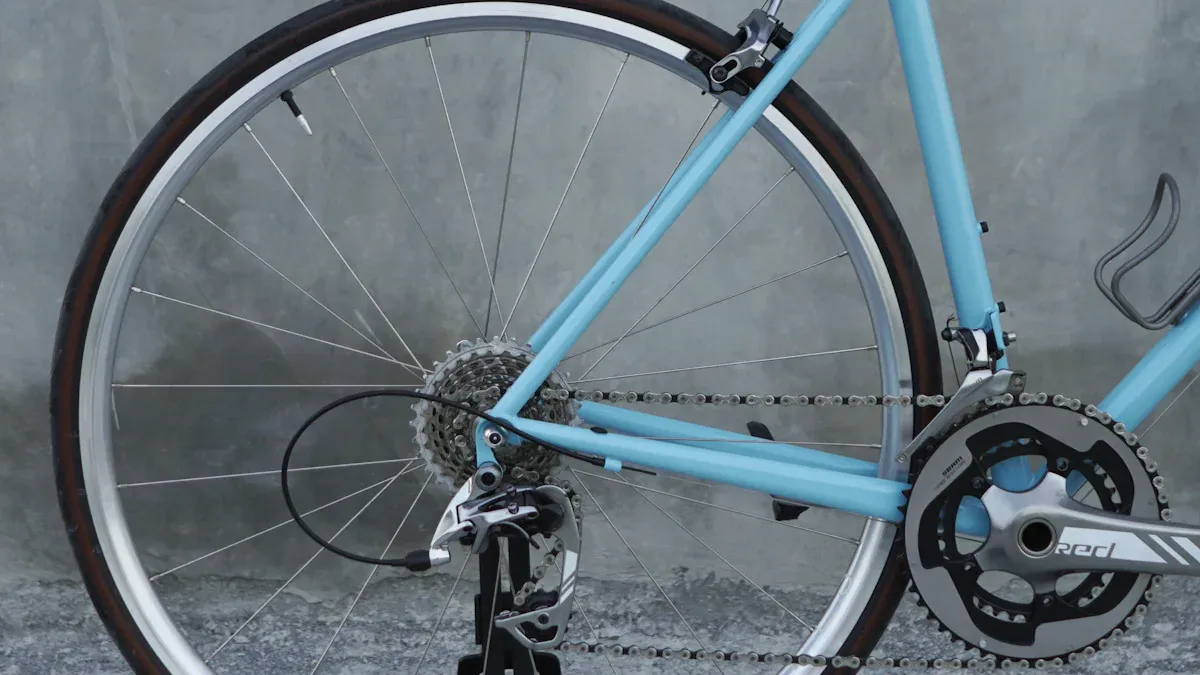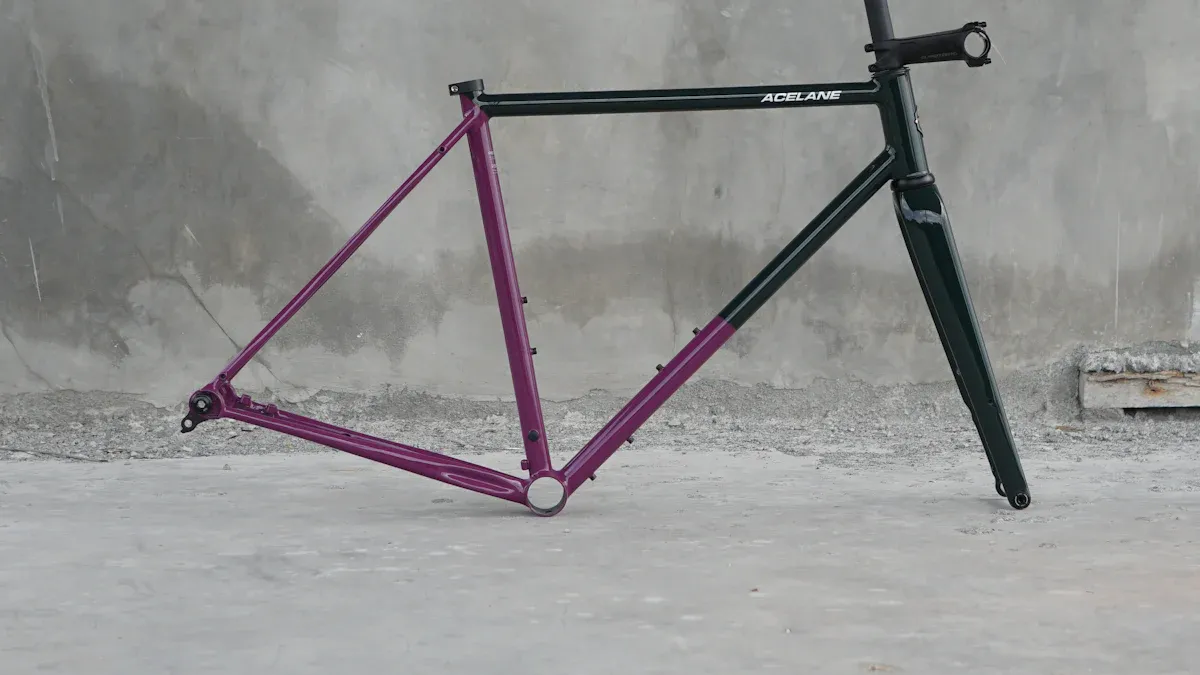
Understanding race bike frame geometry is very important. It helps you perform better and feel comfortable on the road. The bike frame design affects how you control your ride. A good carbon fiber bike frame can boost your speed and control. Different frame shapes fit different riding styles and likes. By picking the right materials and shape, you can greatly improve your cycling experience.
Key Takeaways
Picking the right bike frame shape helps you ride better. It gives you more control, comfort, and speed on the road.
The head tube angle and wheelbase change how your bike turns and stays steady at fast speeds.
Stack and reach measurements help you sit comfortably while riding. This supports your power and makes you less tired.
Shorter chainstays make your bike speed up faster and handle quickly. Longer chainstays give you more stability for climbing and long rides.
To avoid sizing mistakes, think about how you ride. Get professional fittings and try bikes before you buy one.
Head Tube Angle

Handling Impact
The head tube angle is very important for how your bike rides. A steeper head tube angle is common in race bike frames. It makes your bike respond faster. This helps you turn quickly and go around tight corners easily. When you lean into a turn, the bike feels quicker. You can keep your speed and control better.
On the other hand, a slacker head tube angle gives more stability. This design is good for riders who like a smooth ride over long distances. You might lose some quickness, but you feel safer going fast downhill. Knowing this balance helps you pick the right bike shape for your riding style.
Comparison with Endurance Geometry
Race geometry and endurance geometry are very different in design. Race bikes focus on speed and quickness. They have a shorter wheelbase and a more aggressive riding position. This setup helps you perform your best during races.
Endurance bikes, however, are made for comfort and stability. They have a longer wheelbase and a more relaxed head tube angle. This design helps you feel less tired on long rides. If you want to ride for hours, an endurance bike might be better for you.
Wheelbase
Stability vs. Agility
The wheelbase of a bike is very important for how it rides. A longer wheelbase gives more stability. This helps you stay in control when going fast. Endurance bikes usually have a longer wheelbase than race bikes. This design makes the ride smoother over long distances.
But, this stability has a downside. A longer wheelbase can make the bike less quick. You might find it tough to turn sharply. On the other hand, a shorter wheelbase makes the bike more agile. It allows for quicker turns and faster reactions. Race bikes often use this design to improve performance in races.
Ride Quality
The ride quality of your bike depends a lot on its wheelbase. A longer wheelbase usually means a smoother ride. It handles bumps better, which is great for long rides. This design helps you feel more relaxed, especially on bumpy roads.
In contrast, a shorter wheelbase can give a more exciting ride. You may feel closer to the road, which boosts your confidence when turning. However, this can also make the ride rougher, especially on uneven ground.
Stack and Reach

Fit and Comfort
Stack and reach measurements are very important for your fit and comfort on a race bike. Stack is the vertical distance from the bottom bracket to the top of the head tube. Reach is the horizontal distance from the bottom bracket to the top of the head tube. These two measurements greatly affect how you sit on the bike.
When you change stack and reach, you can make your ride more comfortable. For example, raising the stack height by 40-60mm helps you sit with a more relaxed back. This change opens your hip angles. It reduces body limits that can cause power loss. You might also notice that extending reach by 60-100mm helps you keep a better upper body position. This supports your shoulders and makes riding more comfortable.
Aerodynamic Posture
Your aerodynamic posture is key for going fast and being efficient. A good stack and reach setup helps you get into the best aero position. By avoiding very low and compact positions, you can keep better support for your upper body. This change helps you reduce drag while still keeping your power.
Many competitive cyclists now prefer longer reach and higher stack setups. For example, athletes like Sam Appleton have raised their stack by 50mm and reach by 80mm over time. This change in bike design pushes manufacturers to create frames that fit these new positions. You can also improve your ride by tilting the handlebars slightly by 10-20 degrees. This supports your upper body and creates aerodynamic pockets that help reduce drag even more.
Chainstay Length
Acceleration and Climbing
Chainstay length is very important for how your bike speeds up and climbs. A shorter chainstay helps you speed up faster. This design lets you use your leg power better. When you push down on the pedals, the bike reacts quickly. This quick response is key in races, where every second matters.
On the other hand, a longer chainstay gives more stability. This stability helps you stay in control when going up steep hills. You can balance your weight better, which helps with grip. If you like climbing or riding on tough trails, think about a bike with a longer chainstay. It can give you the balance you need for those hard climbs.
Race vs. Endurance Bikes
Race bikes and endurance bikes are very different in chainstay length. A race bike usually has a shorter chainstay. This design makes it more agile and responsive, which is great for racing. You can turn sharply and speed up quickly, which is important in competitions.
In contrast, endurance bikes have longer chainstays. This design focuses on comfort and stability instead of speed. You can ride for longer without getting tired. The longer chainstay helps smooth out bumps from the road, giving you a better ride. If you want to ride for hours, an endurance bike might be a better choice for you.
Frame Geometry Overview
Importance of Measurements
When picking a race bike, knowing frame geometry measurements is very important. These measurements affect how you ride. Here are some key things to think about:
Stack and Reach: These measurements decide your riding position. A good fit makes you more comfortable and efficient.
Head Tube Angle: This changes how the bike handles. A steeper angle makes it more agile, while a slacker angle gives stability.
Seat Tube Angle: This affects how well you pedal and your comfort. A steeper angle helps you stay powerful while riding.
Top Tube Length: This impacts how far you reach and your overall fit on the bike.
Chainstay Length: This influences how fast you can accelerate and climb. Shorter chainstays make the bike respond quicker, while longer ones add stability.
Wheelbase: This measurement affects how stable and agile the bike is. A longer wheelbase gives a smoother ride, while a shorter one allows for faster turns.
Bottom Bracket Drop: This changes your center of gravity and how the bike handles.
Fork Rake/Offset and Trail: These measurements affect how the bike steers and its stability.
Each of these factors matters in how you ride your bike. Choosing the right geometry can improve your performance and comfort on the road.
Common Mistakes
Many cyclists make mistakes when choosing frame geometry. Avoid these common errors for a better fit and riding experience:
Don’t pick a frame size just based on your last bike size. Different geometries can fit differently.
Don’t ignore sizing differences between brands. Sizes can change a lot from one brand to another.
Avoid choosing a frame size just because it’s on sale. A proper fit should always be the priority.
Think about your riding style and flexibility. These things greatly affect your best frame geometry.
Always do test rides before buying. This helps you check comfort and handling.
Don’t choose a smaller size thinking you can fix it with longer stems or seat post changes. This can mess up weight balance and handling.
Get a professional fitting from certified bike shops. They can take detailed measurements to help you choose.
Know the key frame geometry elements. Understanding how stack and reach, head tube angle, and other measurements affect fit and handling is very important.
Take accurate body measurements. Your height, inseam, torso length, arm length, and shoulder width help you pick the right frame size.
Use bike type-specific sizing methods. Focus on reach and stack for road bikes, and check manufacturer size charts as starting points.
By avoiding these mistakes, you can get a better fit. This leads to more comfort, efficiency, and performance on your race bike.
Knowing about race bike frame geometry is very important for how well you ride. The right geometry helps you control your bike better and ride more efficiently. It also affects how comfortable you feel during your rides.
Think about getting help from fitting experts. They can assist you in finding the best bike setup for you. A good fit can really change how you enjoy riding.
Spending time to learn about these parts will help you have better rides and more fun on your bike.
FAQ
What is race bike frame geometry?
Race bike frame geometry means the specific sizes and angles of a bike’s frame. These parts affect how the bike handles, how comfortable it is, and how well it performs. This makes them very important for competitive cyclists.
How does head tube angle affect my ride?
The head tube angle changes how your bike handles. A steeper angle helps you turn quickly. A slacker angle gives you more stability, especially when going fast.
Why is wheelbase important?
Wheelbase is important for stability and agility. A longer wheelbase makes the ride smoother and more stable. A shorter wheelbase allows for quicker turns and better control, which is great for racing.
What are stack and reach?
Stack and reach are measurements that help decide your riding position. Stack measures how high the bike is, while reach measures how far it goes forward. Together, they affect how comfortable and efficient you feel on the bike.
How can I choose the right frame geometry?
To pick the right frame geometry, think about your riding style, body size, and comfort needs. Test rides and professional fittings can help you find the best fit for you.
